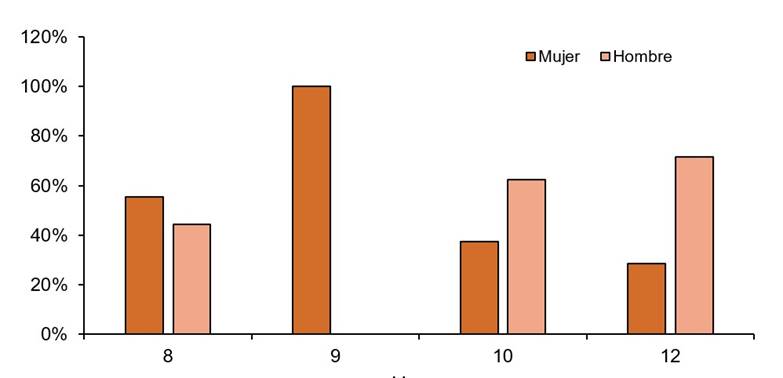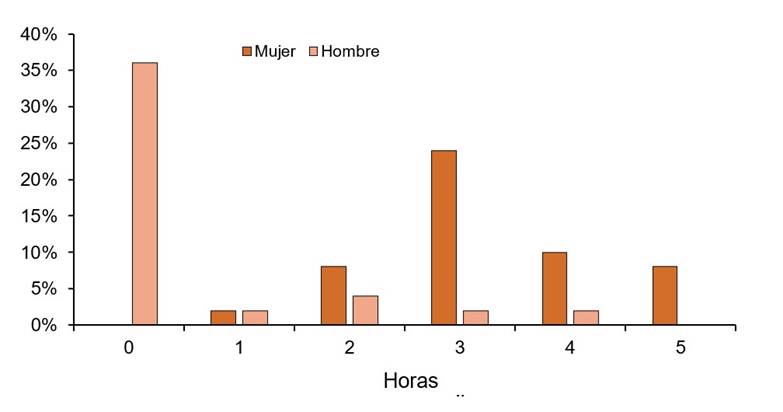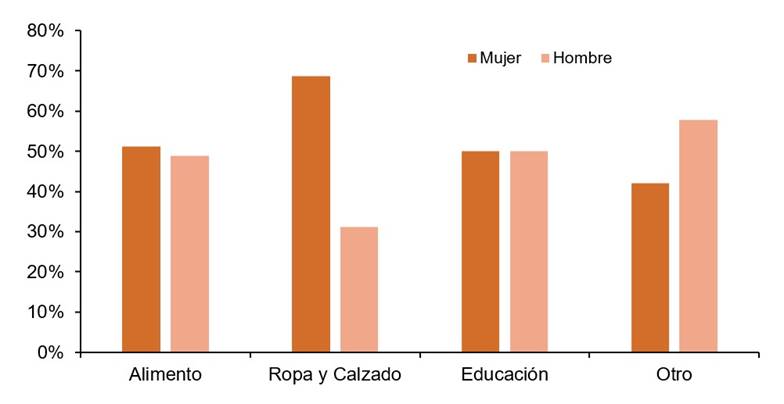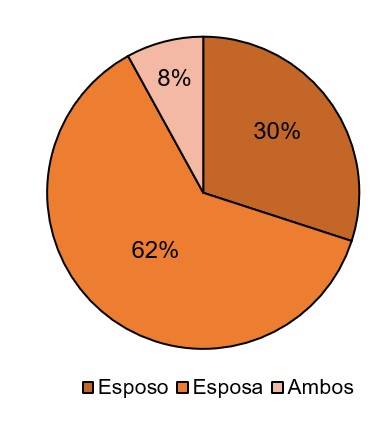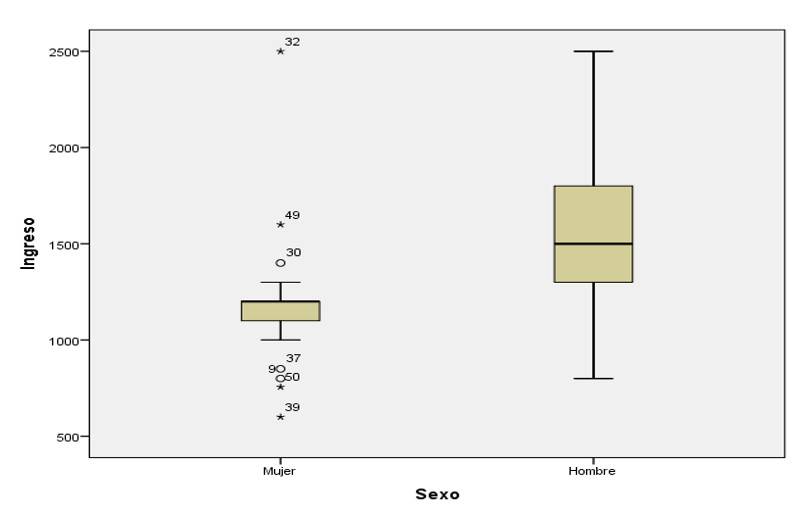Serviços Personalizados
Journal
Artigo
Indicadores
-
 Citado por SciELO
Citado por SciELO -
 Acessos
Acessos
Links relacionados
-
 Similares em
SciELO
Similares em
SciELO
Compartilhar
Revista mexicana de ciencias agrícolas
versão impressa ISSN 2007-0934
Rev. Mex. Cienc. Agríc vol.14 no.5 Texcoco Jun./Ago. 2023 Epub 15-Set-2023
https://doi.org/10.29312/remexca.v14i5.3062
Articles
Context of women in agriculture in Baja California Sur
1Universidad Autónoma de Baja California Sur. Carretera al Sur km 5.5 Col. Mezquitito, La Paz, Baja California Sur, México. CP. 23080. (mcoronado@uabcs.mx).
2Universidad de Sonora. Blvd. Luis Encinas J, Calle Av. Rosales, Centro, Hermosillo, Sonora. CP. 83000. (shamir.rojas@unison.mx; alma.leyva@unison.mx; sergio.rossetti@unison.mx).
This research allowed us to know the factors that affect the productivity of women in agriculture, as well as to explore the existing working conditions that could also impact the role of women in their productive environment. The study was conducted in 2019. The objective of this work was to identify the main problems experienced by women with respect to men in the sustenance of households and performance in agricultural activities. To this end, a descriptive study of mixed approach was carried out, which was applied in two agricultural regions of BCS, collecting information through a survey. The results show differences in relation to income, working hours, management of household expenses and time spent on domestic work. The work concludes that there is no equality, so it is important to promote the value of people of both sexes in the social dynamics of the communities analyzed.
Keywords: agricultural activities; gender equity; labor differences; rural women
La presente investigación permitió conocer los factores que inciden en la productividad de las mujeres en la agricultura, así como explorar las condiciones de trabajo existentes, que también pudieran impactar el rol de la mujer en su ámbito productivo. El estudio se realizó en el año 2019. El objetivo de este trabajo fue identificar los principales problemas que vive la mujer con respecto a los hombres en el sustento de los hogares y desempeños en actividades agrícolas. Para ello, se realizó un estudio descriptivo de enfoque mixto aplicado en dos regiones agrícolas de BCS, recopilándose información mediante encuesta. Los resultados muestran diferencias en relación con los ingresos, las jornadas laborales, la administración del gasto familiar y el tiempo que destinan al trabajo doméstico. El trabajo concluye que no existe igualdad, por lo que es importante propiciar el valor de las personas de ambos sexos en la dinámica social de las comunidades analizadas.
Palabras claves: actividades agrícolas; diferencias laborales; equidad de género; mujer rural
Introduction
The agricultural sector in Latin America and the Caribbean has few women in farm positions (8-30%) and most of the benefits go to men, limiting women’s access to resources and technology (FAO, 2016). Although women’s access to participation in the sector has been encouraged, there are still marked differences in working and wage conditions compared to men. Women are often assigned specific roles and perform more hours of both paid and unpaid work, which limits their economic development (Chiappe, 2005).
FAO (2004) emphasizes that women are central to the rural economy, but they are not valued or recognized as such. Discrimination against women in relation to men is a serious problem that persists despite the efforts of the government and social organizations in Mexico. This phenomenon is reflected in different areas, including work and opportunities for improvement. In the rural sector, where women represent 43% of the agricultural workforce, they face inequalities because their work is devalued, and they are considered responsible for household care and reproduction (FAO, 2011). Despite this, women are agents of change and a key player in sustainable, social and economic development (Chinchilla, 2018).
Lahoz (2011) pointed out that women are responsible for half of the world’s food production and produce between 60 and 80% of the food in developing countries, since they play such an important role in the food system, that the food security of families depends on them. On the other hand, FAO (2011) indicated that, if women had the same access as men to productive resources, they would increase the yields of their productive units by 20 to 30%, which would lead to an increase in agricultural production of 2.5 - 4% in developing countries. The importance of women’s participation lies not only in productive issues, but also that women are the ones that are mainly responsible of buying and preparing food, as well as of taking care of the home, children, sick and elderly relatives, among other domestic chores, which represent an unpaid workload, which translates into a clear example of gender inequality.
Considering the results of the study by Ramírez (2012), women in the rural sector of Mexico and Central America are at a disadvantage compared to men because they do not receive an adequate economic reward for their activities, despite the fact that they work more hours in the fields, with the average working week being 58.5 hours for men, while for women it is 88.7 hours. Almost 60% of employed rural women work independently or unpaid family labor, while just over 28% work as wage earners in the private sector (OIT, 2014).
There are also notable differences in land tenure; in Latin America and the Caribbean, the ratio of men to women landowners is 80% for men and 20% for women (Cliche et al., 2015). The research seeks to identify the working conditions of rural women in the Agricultural Valley of the Municipality of La Paz in BCS, to design strategies that allow the mitigation of the problems they face and the promotion of the value towards the female population. It is sought to identify the main problems and propose solutions to generate research bases and strategies.
The study is based on the experiences of women and men working in agricultural activities in the region, with the aim of identifying the problems faced by women in household sustenance and their performance in agricultural activities. It is sought to formulate strategies that favor gender equality in the sector and increase the efficiency and productivity of women, improving their living conditions and those of their families without discrimination. Women’s participation in rural areas is increasing and it is important to explore existing working conditions and factors affecting their productivity.
Materials and methods
The present study was descriptive and mixed-approach, due to the use of numerical variables and attributes of the population analyzed. The research was carried out in the Ejido Melitón Albáñez Domínguez located in the municipality of La Paz in the state of Baja California Sur, at the geographical coordinates: latitude 23.661667 and longitude -110.420833, at a medium height of 25 masl, in 2019. This community was chosen because agricultural activity predominates there.
The study population were women and men of legal age that participate in agricultural activities, which were delimited in size by sample calculation using the formula proposed by Galindo (1998), for studies within the social sciences:
The population universe consisted of N= 1 154 people, both men and women (Giovannelli, 2016) and the sample generated was n= 50 people.
Information was collected using the survey technique, considering the following variables: sex, age, marital status, level of education, job position, hours worked per day, monthly income, economic dependents, type of employment contract, type of medical service, labor problem due to gender, management of household expenses, hours of domestic work, work identity (work environment). The data collection instrument (questionnaire) included dichotomous, multiple-choice, and open-ended questions. The Microsoft Excel program was used to analyze and present the data, and the SPSS software (BM SPSS Statistics 20.0) was used to classify and analyze the information.
Results
A total of 50 people were interviewed, 54% represents women and 46% men. The age range of the women interviewed was 20 to 56 years, that of the men was similar since the age range was 20 to 50 years. With regard to marital status, 46% of interviewees mentioned being in a consensual union, married people were represented by 38% and 16% said they were single. Regarding the number of children, of the 50 interviewees, it was obtained that 34% have two children, followed by people who have three children represented by 28%, people with one child represent 24%, 6% of them have more than four children, while the remaining 8% said they have no children.
On the other hand, it was found that most people are from other states of the Mexican Republic: Sinaloa 10%, Veracruz 52%, and Oaxaca 16%. As can be seen in Figure 1, only 2% of the interviewees belong to the state of Baja California Sur. Of the total number of people, 96% said they had a written employment contract.
Ninety percent of the people surveyed said that their employer provides them with medical service through the Mexican Institute of Social Security (IMSS, for its acronym in Spanish), as long as they comply with their mandatory workdays, which are six days a week. While 10% said they do not have any type of medical service. Another aspect addressed in the survey was gender discrimination, with both men and women responding that they had not experienced employment discrimination because of this. In addition, they were asked if they felt comfortable with their co-workers and with work, 82% answered yes and 18% said they were not.
Among the reasons why they feel comfortable, it was found that the work is calm and does not require a lot of effort, they also mentioned getting along with their co-workers. The reasons why they feel uncomfortable were because their co-workers are problematic, and some have drug addiction or because the work is too heavy. With regard to the level of education, it was found that women have completed more years of study than men (Figure 2), except in elementary school where there are more men who completed that level. It was found that only one woman of the respondents has completed a technical bachelor’s degree, but in contrast, it was obtained that there are more women than men who did not study.
Fifty-nine percent of the women surveyed mentioned that in their work they carry out activities related to tomato and chili harvesting, also 33% of them mentioned carrying out pest monitoring, and only two women said they worked in nurseries. On the other hand, 17% of the men surveyed said they have worked in chili and tomato harvesting. Men also work in activities related to irrigation, maintenance of greenhouses and they operate machinery, such as tractors and trucks that carry the fruit and agricultural personnel.
It was found that the working days range from 8 to 12 h. Figure 3 shows that the more the hours of work increase, the less women work those hours, the opposite happens with men. This indicates that women only perform the work of a normal working day without overtime.
Regarding income, Figure 4 shows that men’s incomes are higher than women’s incomes, women’s salaries do not exceed $1 600.00 per week, unlike men who reach incomes up to $2 600.00.
Concerning domestic work, 78% of men do not do an hour of this activity (Figure 5) and the remaining 22% work from 1 to 4 hours at home. All women do between 1 or 6 hours of work at home.
As for the destination of income, both men and women allocate it to a greater extent to food, as can be seen in Figure 6. So, it can be said that most women working in the sector perform such activities to meet basic needs and not only as an alternative income.
With respect to who manages household expenses, it is the wife who in most cases performs this task, as shown in Figure 7.
Inferential Analysis, Sex of the interviewees in relation to their comfort at work. When crossing the variables sex and comfort at work, after doing the chi-square test, no statistically significant differences were found in both groups. Nonetheless, there is a difference in the proportion of men who feel uncomfortable with their co-workers, which may be due to the situation that men are uncomfortable feeling that women perform their same functions (Chiappe, 2005) (Figure 8).
As can be seen in Table 1, at a significance level of alpha of 0.05, there is no statistical significance in the chi-square test since a p-value of 0.094 was obtained. This means that while there are differences in the proportion of men and women who feel comfortable and uncomfortable at work, the results of the test indicate that it cannot be concluded that the variables are associated. An exploratory analysis of the variables sex of the interviewees and hours of work was carried out. For this analysis, the box plot was used for both groups.
Table 1 Chi-square tests.
| Test | Value | df | Asymptotic significance (two-sided) | Exact significance (two-sided) | Exact significance (one-sided) |
| Pearson’s chi-square | 2.803a | 1 | 0.094 | ||
| Continuity correctionb | 1.801 | 1 | 0.18 | ||
| Likelihood ratio | 2.924 | 1 | 0.087 | ||
| Fisher’s exact test | 0.112 | 0.089 | |||
| Linear-by-linear association | 2.747 | 1 | 0.097 |
Based on the analysis of the data describing the behavior of the working day in both sexes, apparently women are more consistent in their work, as can be seen in Figure 9. In this sense, the data contextualize the contributions of (Ballara and Parada, 2009) and Lahoz (2011), who highlight the importance of women in productivity.
An inferential analysis was performed with the variables sex in relation to their income. For this analysis, the Shapiro-Wilk normality test was applied, rejecting the null hypothesis of normality of the data because in group 1 (women) there is no statistical significance in the test since a p-value of 0.103 was obtained, which is higher than the significance level of alpha of 0.05. Therefore, it was decided to use the Mann-Whitney U test for non-normal data (Table 2). This test showed statistical significance since a p-value of 0.002 was obtained, which is lower than a significance level of alpha of 0.05. These statistical results are relevant in the issue of women’s income, because there is a variability, in accordance with the contribution of de Millán (2002) (Figure 10).
Discussion
As Ruiz and Castro (2011) point out, in Latin America, women have the lowest levels of education; however, the results obtained show the opposite since, in the Ejido Melitón Albáñez, women are the ones who have achieved more schooling, even with a technical bachelor’s degree, while men have not. The number of women and men who did not study is similar, between them there is only a difference of one person who did not course any level.
Authors such as Flores (2011) mention that paid work is an employment opportunity for rural women, so that they can obtain income for their sustenance and that of their families; however, wages are very low, which affects their standard of living, as perceived in the results of this research, which shows that women’s wages are much lower than men’s. Valdés (2012) mentions that women in agricultural work have access to temporary jobs, which causes the informality of employment and precarious working conditions; nevertheless, in this research it was shown that they do have a contract that supports both them and men and that, in addition, they have a guaranteed service that sees for their health.
According to Rodríguez (2007), a division of labor by sex has prevailed since ancient civilizations; that is, men and women play different roles in the work aspect. In this sense, the results generated show that women perform activities that require less physical effort such as pest monitoring, which consists of observing to detect what pests the plant has, they also participate in activities related to the care of children.
In contrast, men perform activities of greater responsibility and physical effort, such as operating agricultural machinery, such as trucks that transport personnel, irrigation of the plantation, maintenance of greenhouses and machinery, in addition to performing administrative activities related to the issuance of invoices, collections and payments of the company. However, it is worth mentioning that there are activities that they perform regardless of sex, these activities are the harvesting of chili and tomato, as well as their packaging.
The results underline that women can generate discomfort in men, which is probably due to feeling a kind of invasion of functions that are considered exclusive to their sex (Chiappe, 2005). In this sense, women continue to be productive and consistent in their work, as highlighted by Ballara and Parada (2009); Lahoz (2011), even if their income does not correspond, in some cases, to their time and effort at work. Considering Hernández (2004), who mentions that women seek the alternative of employment in order to obtain extra income for their family, most of the women interviewed allocate their income to family food, as support for the spouse or as heads of family.
According to the ONU (2016) and IMECAM (2016), women are key to obtaining food and nutrition security, generating income, and improving the livelihoods and well-being of their households, perhaps that is why this research found that women are responsible for managing household expenses, and are forced to see mainly for the well-being of their household before theirs. Far from being an attribute that they have, it is an extra responsibility assigned to them.
According to FAO (2016); Flores (2011), women are responsible for performing domestic work, which is not valued or paid; in this case there is consistency, since the research describes that it is mostly women who are responsible for domestic chores, which include childcare, food preparation, washing clothes and crockery, household cleaning, among others; on the other hand, three quarters of the men surveyed said they did not perform an hour of chores at home, which represents an obvious difference between the role played by men and women.
According to Hernández (2004), the most common activities in which the female population is involved in rural areas are those that allow them to have an accessible schedule to be able to carry out their domestic activities, the same case arose in the research since most women maintain a schedule of activities between 8 and 9 h, this confirms that most of these women carry out activities that allow them to earn an income without neglecting the home.
Finally, in congruence with Gámez-Wilson and Boncheva (2010), who point out that there is strong immigration in the state, this must be due to the opportunity represented by agricultural activities since, according to the results, 90% of the people who were surveyed and who work in agriculture are from other states of the republic, attracted because in the state they aspire to better conditions of employment and wages than in their places of origin.
Conclusions
Women’s working conditions in agricultural activities, such as gender inequality, were identified. Unfavorable working conditions in the rural areas of the study, despite the fact that they carry out different agricultural activities, there is still no such gender equity, as they cannot access certain job positions, have lower incomes and perform more unpaid work; since, in addition to being the breadwinner of their family, they have to perform tasks such as domestic work and be the administrator of family income, which implies more workload and time, limiting their access to jobs that require more time, which can be better paid.
It is important to recognize and value the work carried out by women, carrying out development actions and projects based on their true needs, so that they can be given the opportunity to demonstrate their capacities and skills, where not only institutional gender policies are carried out, but also attacks from more depth, that is, from society itself, so that awareness is created of how devalued women are according to the activities they perform and that are not taken into account, but especially of the benefits that can result if they are given the opportunity to be on par with men in the labor and social sphere, since to give them the value they really deserve, it is necessary to eradicate the gender gap before society.
It is important to generate both social and institutional commitments and responsibilities from a municipal policy to design and finance projects with a broader vision, where solutions to the problems that women in the region have been raised.
On the other hand, the entrenched culture of machismo must be ended, so men must consider and share domestic chores with women. Therefore, based on the findings obtained, it has been possible to affirm the hypothesis of the research since women, as agricultural workers, are valued as gender discrimination against them decreases.
Bibliografía
Ballara, S. M. A. y Parada, S. 2009. El empleo de las mujeres rurales: lo que dicen de las cifras. FAO-CEPAL. Italia. 96 p. [ Links ]
Chiappe, M. B. 2005. La situación de las mujeres rurales en la agricultura familiar de cinco países de América Latina. ALOP. Uruguay. 33 p. [ Links ]
Chinchilla, M. L. y Otero, M. 2018. El empoderamiento de las mujeres en los entornos rurales: avances y desafíos en el contexto de la Agenda 2030. Costa Rica. Rev. Luchadoras. 33-39 pp. [ Links ]
Cliche, G.; Ranaboldo, C. y Serrano, C. 2015. Enfoque territorial para el empoderamiento de la mujer rural en América Latina y el Caribe. Impresiones y Ediciones Arteta EIRL. Perú. 119 p. [ Links ]
FAO. 2004. Organización de las Naciones Unidas para la Agricultura y la Alimentación. Servicio de género y desarrollo de la oficina regional de América Latina. 9a Conferencia regional sobre la mujer de América Latina y el Caribe. México, DF. 7 p. [ Links ]
FAO. 2011. Organización de las Naciones Unidas para la Agricultura y la Alimentación. Estado mundial de la agricultura y la alimentación. Italia. [ Links ]
FAO. 2011. Organización de las Naciones Unidas para la Agricultura y la Alimentación. Las mujeres en la agricultura: cerrar la brecha de género en aras del desarrollo: http://www.fao.org/publications/sofa/2010-11/es/. [ Links ]
FAO. 2016. Organización de las Naciones Unidas para la Agricultura y la Alimentación. ¿Qué significa ser mujer rural?. [ Links ]
FAO. 2016. Organización de las Naciones Unidas para la Agricultura y Alimentación. Oficina Regional de la FAO para América Latina y el Caribe: http://www.fao.org/3/a-as107s.pdf. [ Links ]
Flores, M. K. 2011. La agroexportación no tradicional en el país de las maravillas. Condiciones de trabajo y derechos laborales de las mujeres. Asociación Aurora Vivar, Perú. 76 p. [ Links ]
Galindo, C. J. 1998. Técnicas de investigación en sociedad, cultura y comunicación. México. Ed. Pearson. 9-32 pp. [ Links ]
Gámez, A. E.; Wilson, T. D. y Boncheva, A. I. 2010. Las mujeres en la migración interna y el empleo informal en Baja California Sur, México. Rev. de Estudios de Género. La ventana. 4(32):214-243. [ Links ]
Giovannelli, C. 2016. Melitón Albáñez Domínguez-Baja California Sur. Nuestro México. http://www.nuestro-mexico.com/Baja-California-Sur/La-Paz/Meliton-Albanez-Dominguez/. [ Links ]
Hernández, S. M. 2004. Situación actual de las mujeres en el medio rural y los nuevos espacios laborales en Tabasco México. México. Asociación Ecológica Santo Tomás, AC. 48-60 pp. [ Links ]
IMECAM. 2016. Día internacional de la mujer rural de IMECAM (Instituto de la Mujer del Estado de Campeche). http://imecam.gob.mx/blog/2016/10/dia-internacional-de-la-mujer-rural. [ Links ]
Lahoz, D. 2011. Mujeres campesinas y su papel en el sistema alimentario en México. México, DF. Oxford Committee for Famine Relief (OXFAM). 60 p. [ Links ]
OIT. 2014. Notas sobre un trabajo rural número 3. Condiciones de trabajo de las temporeras agrícolas en américa latina y el caribe precariedad y vulnerabilidad social. Organización Internacional del Trabajo (OIT). 1-4 pp. [ Links ]
ONU. 2016. La mujer rural y los objetivos del desarrollo del milenio de Naciones Unidas. Organización de las Naciones Unidas (ONU). Nueva York, Estados Unidos. https://www.un.org/womenwatch/feature/ruralwomen/documents/Es-Rural-Women-MDGs-print.pdf. 6-12 pp. [ Links ]
Ramírez, S. D. 2012. Productividad agrícola de la mujer rural en Centro América y México. México, DF. CEPAL subsede de México. 51 p. [ Links ]
Rodríguez, J. O. M. 2007. Evolución del concepto de la mujer en José Martí 1887-1895. Costa Rica.. Rev. Cienc. Soc. 2(116):103-111. [ Links ]
Ruiz, B. P. y Castro, M. D. 2011. La situación de las mujeres rurales en América Latina. In: mujer rural: cambios y persistencias en América Latina. CEPES. Lima, Perú. 1-36 pp. [ Links ]
Received: February 01, 2023; Accepted: May 01, 2023











 texto em
texto em 



